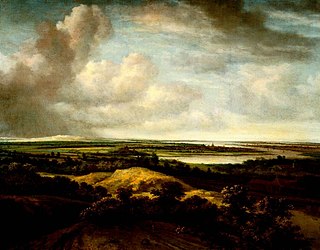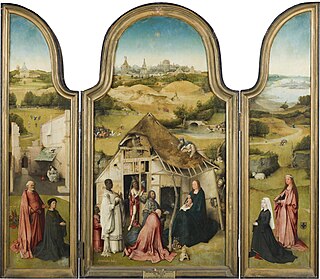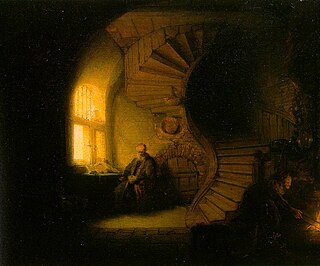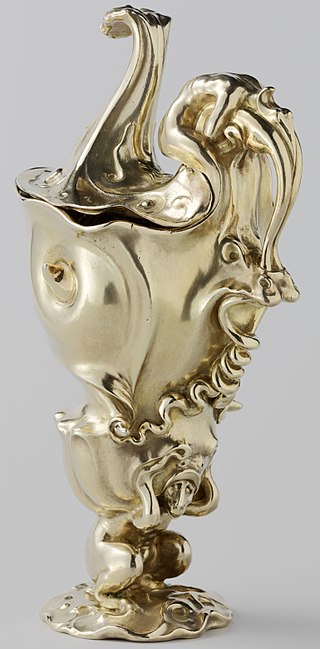
The Adoration of the Magi or Adoration of the Kings or Visitation of the Wise Men is the name traditionally given to the subject in the Nativity of Jesus in art in which the three Magi, represented as kings, especially in the West, having found Jesus by following a star, lay before him gifts of gold, frankincense, and myrrh, and worship him. It is related in the Bible by Matthew 2:11: "On entering the house, they saw the child with Mary his mother; and they knelt down and paid him homage. Then, opening their treasure chests, they offered him gifts of gold, frankincense, and myrrh. And having been warned in a dream not to return to Herod, they left for their own country by another path".

Philip de Koninck, or Philips Koninck (5 November 1619 – 4 October 1688 was a Dutch landscape painter and younger brother of Jacob Koninck.

Rembrandt Harmenszoon van Rijn, usually simply known as Rembrandt, was a Dutch Golden Age painter, printmaker, and draughtsman. An innovative and prolific master in three media, he is generally considered one of the greatest visual artists in the history of art. It is estimated Rembrandt produced a total of about three hundred paintings, three hundred etchings, and two thousand drawings.

The Adoration of the Magi or The Epiphany is a triptych oil painting on wood panel by the Netherlandish artist Hieronymus Bosch, executed around 1485–1500. It is now in the Museo del Prado in Madrid, Spain.

Gerard or Gérard (de) Lairesse was a Dutch Golden Age painter and art theorist. His broad range of skills included music, poetry, and theatre. De Lairesse was influenced by the Perugian Cesare Ripa and French classicist painters such as Charles le Brun, Simon Vouet and authors such as Pierre Corneille and Jean Racine. His importance grew in the period following the death of Rembrandt. His treatises on painting and drawing, Grondlegginge Ter Teekenkonst (1701), based on geometry and Groot Schilderboek (1707), were highly influential on 18th-century painters.

Salomon (de) Koninck was a Dutch painter of genre scenes and portraits, and an engraver.

The Adoration of the Magi is a 1619 Baroque painting by the Spanish artist Diego Velázquez now held in the Museo del Prado. It shows three kings presenting gifts to the Christ child: Melchior, who kneels in the foreground; Balthazar, who stands behind him wearing a red cape and a lace collar; and Caspar, who appears between the other two. An unidentified young man who stands behind Balthazar is looking on. Kneeling near the Virgin's left shoulder is Saint Joseph. The size and format of the painting indicate that it was made for an altarpiece.

Museum Bredius is a museum named after Abraham Bredius on the Lange Vijverberg in The Hague. It is remarkable for its collection of etchings and paintings, but is most attractive to visitors for its accurate restoration of the 18th-century Herenhuis interior with period furnishings.

Abraham de Vries was a Dutch painter who was one of the leading portraitists of his age. As he led a peripatetic lifestyle and worked in France, Antwerp and the Dutch Republic his stylistic qualities are difficult to pin down.

The Adoration of the Kings is a large oil-on-oak painting by Jan Gossaert, dated to 1510–15, depicting the Adoration of the Magi. Although Gossaert's name is signed on the border of Balthazar's richly embroidered headdress, and on a collar worn by Balthazar's turbaned attendant, the painting was occasionally attributed to Albrecht Dürer in the 17th and 18th centuries. In 2010, Ainsworth suggested that the work was a collaboration between Gossaert and Gerard David.

Philosopher in Meditation, recently renamed Philosopher in Contemplation by the museum, is the traditional title of an oil painting in the Musée du Louvre, Paris, that is attributed to the 17th-century Dutch artist Rembrandt.

The Adoration of the Kings is an oil-on-panel painting of the Adoration of the Magi by the Netherlandish Renaissance artist Pieter Bruegel the Elder, painted in 1564, and now in the National Gallery, London.

The Master of the Lille Adoration, was an Early Netherlandish painter active in Antwerp, as one of the Antwerp Mannerists. He was first suggested as a distinct but unknown figure in 1995 in an article by Ellen Konowitz, a proposal which has been widely accepted. In 2014, Christie's gave his dates as "active Antwerp by c. 1523/35".

Balthazar, also called Balthasar, Balthassar, and Bithisarea, was according to Western Christian tradition one of the three biblical Magi along with Caspar and Melchior who visited the infant Jesus after he was born. Balthazar is traditionally referred to as the King of Arabia and gave the gift of myrrh to Jesus. In the Catholic Church, he is regarded as a saint.

The Adoration of the Magi is a circa 1480–1485 oil on panel painting of the Adoration of the Magi by the Renaissance artist Geertgen tot Sint Jans. It is held in the collection of the Rijksmuseum, in Amsterdam.

Adoration of the Magi is an oil on panel painting from the early 1520s by the Dutch Renaissance artist Jan Mostaert in the collection of the Rijksmuseum, Amsterdam, where in 2020 it was on display in room 0.1. The panel measures 51 cm × 36.5 cm, and the painted surface a little less at 48.5 cm × 34 cm. It is often called the Mostaert Amsterdam Adoration in art history, to distinguish it from the multitude of other paintings of the Adoration of the Magi.

TheMemorial Guild Cupby Adam van Vianen is a 1614 silver-gilt covered ewer in the Rijksmuseum, commissioned by the Amsterdam goldsmiths' guild to commemorate the death of Adam's brother Paulus van Vianen. It is an iconic symbol of the auricular style developed by the two brothers.

The Adoration of the Magi is a 1517 triptych by the Early Netherlandish painter Jacob Cornelisz. van Oostsanen in the collection of the Rijksmuseum.

The Adoration of the Magi is a painting by Portuguese artist Domingos Sequeira, dated to 1828. It shows the common subject in the Nativity art of the visit by the Three Kings to the infant Jesus, here given a grand theatrical treatment by including their spectacular and exotic retinues.





















